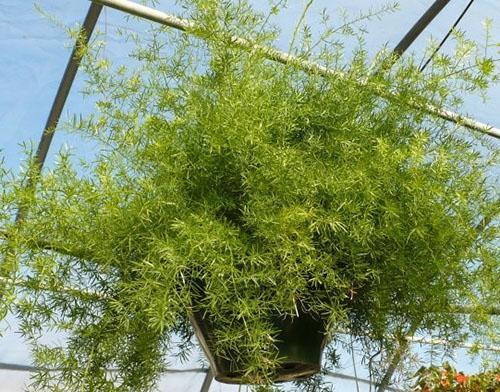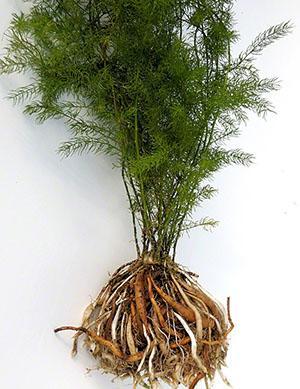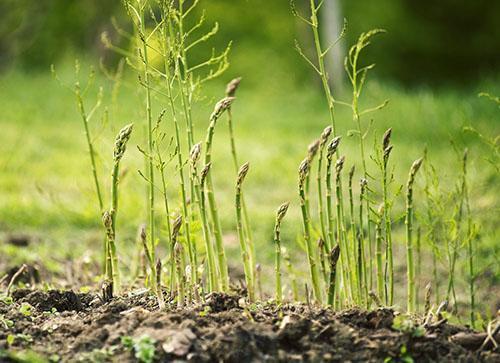Origins and interesting facts about asparagus
 Unpretentious indoor asparagus, flaunting on shelves and window sills in many apartments, are perennial evergreens from an extensive family. At the same time, it was the Asparagaceae family that united such dissimilar cultures as Dracaena, Muscari, Aspidistra, hyacinth and yucca owes its name.
Unpretentious indoor asparagus, flaunting on shelves and window sills in many apartments, are perennial evergreens from an extensive family. At the same time, it was the Asparagaceae family that united such dissimilar cultures as Dracaena, Muscari, Aspidistra, hyacinth and yucca owes its name.
In total, there are about three hundred species of asparagus in nature, some of which are herbaceous plants. Among the representatives of the genus there are large shrubs, creeping species and lianas. It would seem, what could be interesting in plants that have been grown by lovers of indoor floriculture for about a hundred years, unpretentious, long studied and described?
And, nevertheless, interesting facts related to asparagus will make you take a fresh look at this green inhabitant of the house.
The unique structure of the asparagus plant

Where are the leaves? If you look closely, you can find them too. These are dried triangular scales on the stems, in some species taking the form of thorns.
No less interesting is the underground part of asparagus, consisting of elongated bulbous tubers and thin roots. Thanks to tubers, asparagus can accumulate and retain moisture, nutrients and multiply.
Where is the homeland of asparagus?
 Usually, the homeland of asparagus is indicated in the south or eastern regions of Africa. In fact, almost all species grown as house plants originate from these places. But in the wild, a representative of the asparagus genus can be found in India, on the Mediterranean coast of Europe, in the Far East and even in the European part of Russia.
Usually, the homeland of asparagus is indicated in the south or eastern regions of Africa. In fact, almost all species grown as house plants originate from these places. But in the wild, a representative of the asparagus genus can be found in India, on the Mediterranean coast of Europe, in the Far East and even in the European part of Russia.
In the middle lane and in the southern regions of the country, in meadows and in the undergrowth of deciduous forests, you can find up to eight species of asparagus, the most famous of which is the pharmacy asparagus. It is the wild-growing variety of asparagus, whose young sprouts are considered a dietary vegetable and delicacy. Thanks to its powerful tuberous roots, this species of asparagus successfully winters, and the aerial part that has died out in winter is quickly restored in spring.
Asparagus easily adapt to a wide variety of conditions, which leads to a rapid dispersal of plants. The spread of asparagus around the world is facilitated by birds eating the berries of the plant and carrying large black seeds for many kilometers.
 For example, South African species recognized throughout the world as ornamental, being exported to America, Australia, the countries of the Pacific region or other African states, were so easily included in the biocenosis that today they are recognized as weeds. And in some cases, at the state level, decisions are made to combat asparagus plants that occupy the area of agricultural crops.
For example, South African species recognized throughout the world as ornamental, being exported to America, Australia, the countries of the Pacific region or other African states, were so easily included in the biocenosis that today they are recognized as weeds. And in some cases, at the state level, decisions are made to combat asparagus plants that occupy the area of agricultural crops.
 The only exception is the racemosus asparagus.The plant, discovered in 1799 in India, and then found in other areas, such as Nepal, is today on the verge of extinction. This is due to the beneficial properties of asparagus, which the local population calls "shatawari". If we translate the name, consisting of two words shatum - "one hundred" and vari - "healer", it turns out that the species is recognized as "a healer of a hundred ailments." In addition, the energetics of asparagus racemose is extremely favorable, this is the name of the plant in the officially recognized classification.
The only exception is the racemosus asparagus.The plant, discovered in 1799 in India, and then found in other areas, such as Nepal, is today on the verge of extinction. This is due to the beneficial properties of asparagus, which the local population calls "shatawari". If we translate the name, consisting of two words shatum - "one hundred" and vari - "healer", it turns out that the species is recognized as "a healer of a hundred ailments." In addition, the energetics of asparagus racemose is extremely favorable, this is the name of the plant in the officially recognized classification.
Today, a remedy from the thick tuberous roots of the plant, recognized by Ayurveda and folk medicine, has gained fame all over the world, therefore wild-growing racemose asparagus are found less and less frequently.
Interesting facts from the history of asparagus
 The most ancient cultivated species is the pharmacy, medicinal or common asparagus, more often referred to as asparagus. Yes, the dietary asparagus so popular with the French, British and other peoples is asparagus, cultivated for thousands of years in Egypt and the Mediterranean.
The most ancient cultivated species is the pharmacy, medicinal or common asparagus, more often referred to as asparagus. Yes, the dietary asparagus so popular with the French, British and other peoples is asparagus, cultivated for thousands of years in Egypt and the Mediterranean.
Obviously, the first graphic depiction of the asparagus plant dates back to the heyday of Egyptian civilization. Asparagus shoots adorned a fragment of a painted frieze found by archaeologists dating back to the third millennium BC.
In literary sources, asparagus was first mentioned by Apicius, a famous Roman culinary specialist, the author of the world's first book on food "De re coquinaria". Obviously, the Romans had such a passion for tender shoots that they did not refuse their favorite dish even during military campaigns in the Alps. To supply the Roman nobility, a special fleet was created, delivering stems from plantations in the colonies to the metropolis. Asparagus became the most important culture for the empire, as evidenced by the fact that Cato the Elder, a prominent statesman of that era, wrote about the cultivation of asparagus in 160 BC.
 Unlike asparagus, ornamental asparagus began to be cultivated on purpose only a little over a hundred years ago.
Unlike asparagus, ornamental asparagus began to be cultivated on purpose only a little over a hundred years ago.
Such different asparagus
 Asparagus densiflorus became the first in a series of domestic plants of this species. True, due to serious confusion in the classification of plants, for a long time it was referred to as lily and was called Asparagus Sprengeri. Already in recent decades, the asparagus family has undergone a serious reformation, and Sprenger's asparagus has ceased to be a separate species. Now it is a species of densiflorus, bearing the name of Karl Sprenger, who brought the first specimens from Africa and devoted half his life to popularizing the plant among indoor crop lovers.
Asparagus densiflorus became the first in a series of domestic plants of this species. True, due to serious confusion in the classification of plants, for a long time it was referred to as lily and was called Asparagus Sprengeri. Already in recent decades, the asparagus family has undergone a serious reformation, and Sprenger's asparagus has ceased to be a separate species. Now it is a species of densiflorus, bearing the name of Karl Sprenger, who brought the first specimens from Africa and devoted half his life to popularizing the plant among indoor crop lovers.
If this species can rightfully be called the most popular in the world, then asparagus pinnate plants are a kind of record holders for the size of needle cladodia, which are very thin and much shorter than those of other varieties. Plants of asparagus pinnate are in great demand in the East, in China and Japan, because they lend themselves well to shaping and are used in traditional miniature compositions, bonsai.
The largest species of asparagus, although it also needs pruning, cannot be turned into a tiny tree even in decades. Asparagus crescent is an indigenous inhabitant of South Africa, where its powerful shoots grow up to 6-8 meters. In the homeland of asparagus, plants are used as hedge in the fields and agricultural plots. Not only does the perennial culture grow quickly without hassle, its stems easily braid the supports and are equipped with thorns that prevent intruders and wild animals from entering the beds.
 The closest relative of Sprenger's asparagus, the Meyeri asparagus has earned the nickname foxtail because its highly branched shoots are so densely covered with cladodes that the central part of the stem is not visible at all. The thinning shoots towards the end really resemble the fluffy tail of a fox and make this asparagus plant the most interesting of all cultivated species.
The closest relative of Sprenger's asparagus, the Meyeri asparagus has earned the nickname foxtail because its highly branched shoots are so densely covered with cladodes that the central part of the stem is not visible at all. The thinning shoots towards the end really resemble the fluffy tail of a fox and make this asparagus plant the most interesting of all cultivated species.
 Asparagus plants of this species are especially decorative to breeders who have received hybrids with completely white shoots.
Asparagus plants of this species are especially decorative to breeders who have received hybrids with completely white shoots.
Asparagus virgatus is very similar to an asparagus plant, but its shoots cannot be called delicacy. They are completely inedible, but the fluffy stems are of great commercial importance and are actively grown for the needs of florists. Needle phylloclades of asparagus can keep fresh for up to two weeks and perfectly set off the beauty of the most luxurious flowers in bouquets.
Asparagus flowers: signs and meaning
As for the flowers of the asparagus itself, they look like graceful stars, but they are so small that their appearance is not too noticeable and decorative. But with such an inconspicuous event, at home, besides happening irregularly, it became the reason for the emergence of a variety of prejudices and signs.
 One of the signs about blooming asparagus says that this happens to trouble in the house and even the death of one of the household members. It is unlikely that this superstition has real grounds, since the energy of the flower does not carry anything negative, and harm from asparagus is possible only if a person or a pet eats red berries that ripen after flowering. The fruits of the plant contain toxic saponins that irritate the stomach and esophagus mucosa and cause diarrhea, vomiting and other unpleasant symptoms.
One of the signs about blooming asparagus says that this happens to trouble in the house and even the death of one of the household members. It is unlikely that this superstition has real grounds, since the energy of the flower does not carry anything negative, and harm from asparagus is possible only if a person or a pet eats red berries that ripen after flowering. The fruits of the plant contain toxic saponins that irritate the stomach and esophagus mucosa and cause diarrhea, vomiting and other unpleasant symptoms.
 At the same time, even asparagus has much more useful properties, and in the language of flowers, popular in the Victorian era, a sprig of asparagus presented to someone carries a special meaning. The meaning of the asparagus flower, included in a small bouquet or depicted on a souvenir, will certainly appeal to a young lady, because modest stars symbolize natural charm.
At the same time, even asparagus has much more useful properties, and in the language of flowers, popular in the Victorian era, a sprig of asparagus presented to someone carries a special meaning. The meaning of the asparagus flower, included in a small bouquet or depicted on a souvenir, will certainly appeal to a young lady, because modest stars symbolize natural charm.